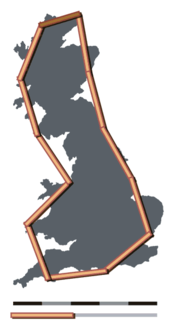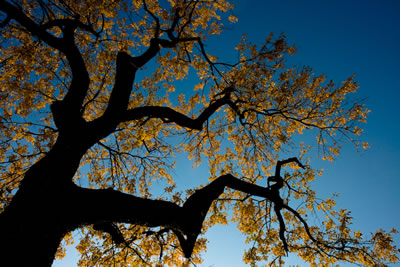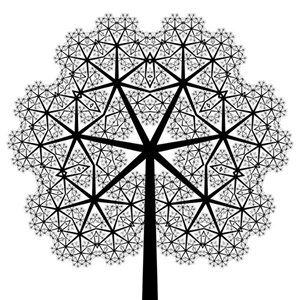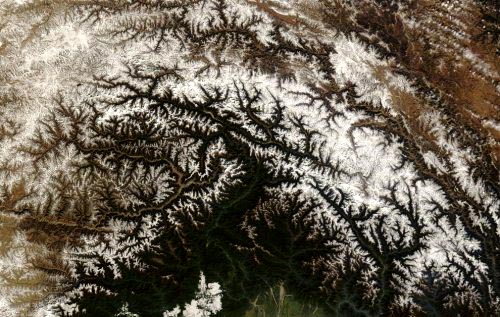On Fractals
One of the interesting things about fractals is that an absolute, agreed upon definition of them does not exist. There are similarities between them, for sure, but there always seems to be an exception, an example that falls outside of the standard that forces the term to be used more broadly while becoming more nuanced. This is fitting, in my opinion, because this dance between specificity and content, the refusal to be pinned down precisely, is exactly what fractals are about. But I'm getting ahead of myself. Let's start with something more concrete.
 Though the discovery of fractals has its origin in mathematics, easier than attempting to understand them through equations or theory is to see their visual representation. Perhaps the most well known fractal is the Mandelbrot set as seen on the right (named after the mathematician Benoit Mandelbrot). Coming out of research in the mid to late 20th century, it is a more recent discovery than the foundations upon which it's built, but it's complexity and striking visual aesthetic caused it to garner much more attention than its older relatives. Perhaps you can already see elements of the natural world in it's shape. We'll get into that in a bit. The Mandelbrot set is also useful because it contains and easily demonstrates two central properties of fractals: recursion and self-similarity. The two ideas are interlinked and while I'm sure someone else could precisely tell you the difference, from my perspective the simple explanation is that recursion creates self-similarity.
Though the discovery of fractals has its origin in mathematics, easier than attempting to understand them through equations or theory is to see their visual representation. Perhaps the most well known fractal is the Mandelbrot set as seen on the right (named after the mathematician Benoit Mandelbrot). Coming out of research in the mid to late 20th century, it is a more recent discovery than the foundations upon which it's built, but it's complexity and striking visual aesthetic caused it to garner much more attention than its older relatives. Perhaps you can already see elements of the natural world in it's shape. We'll get into that in a bit. The Mandelbrot set is also useful because it contains and easily demonstrates two central properties of fractals: recursion and self-similarity. The two ideas are interlinked and while I'm sure someone else could precisely tell you the difference, from my perspective the simple explanation is that recursion creates self-similarity.
Recursion, in math, is feeding the answer back into the equation it came from. The most famous example of this is the Fibonacci sequence: 0+1=1; 1+1=2; 1+2=3; 2+3=5; 3+5=8, etc, etc. The Fibonacci sequence becomes particularly appropriate for this conversation because when mapped out visually it also has an interesting aesthetic, namely the golden spiral or golden ratio. This too has natural phenomenon implications, but since it isn't directly related to fractals I'll do my best to stay on topic.

Recursion, in math, is feeding the answer back into the equation it came from. The most famous example of this is the Fibonacci sequence: 0+1=1; 1+1=2; 1+2=3; 2+3=5; 3+5=8, etc, etc. The Fibonacci sequence becomes particularly appropriate for this conversation because when mapped out visually it also has an interesting aesthetic, namely the golden spiral or golden ratio. This too has natural phenomenon implications, but since it isn't directly related to fractals I'll do my best to stay on topic.




Self-similarity, as the name might suggest, is the idea is that when you zoom in on a portion of a structure, it looks identical or nearly identical to the whole; that each part contains within it the same design as the entirety. Let's take a look at the Mandelbrot set and the Koch snowflake again:



So this is the essence of recursion and self-similarity and is a cornerstone of how we understand fractals and define them. Part of what makes this so interesting to me is that it highlights how closely intertwined fractals are with our concepts of the infinite. Infinite size. Infinite complexity. In an idealized fractal, you can zoom in or out as far as you want and you still end up with the same basic shape following the same basic rules. The only restriction is the amount of time and energy you can devote to rendering. There are many videos on Youtube of these fractal zooms where people spend sometimes literally months having a computer render the same algorithm over and over, going deeper and deeper into the set. A few of them can be found here and here.
There is another example of how fractals and the infinite are so closely related and comes from a paper Mandelbrot wrote in 1975 on measuring the length of objects in the real world. He pointed out that the length of the coastline of a country was entirely dependent on how long the ruler that you measure it with is, so that if you measure England with a 200 kilometer ruler the coast is about 2,400 km long, and that if you measure it with a 50 km ruler it is about 3,400 km long and so on.
There is another example of how fractals and the infinite are so closely related and comes from a paper Mandelbrot wrote in 1975 on measuring the length of objects in the real world. He pointed out that the length of the coastline of a country was entirely dependent on how long the ruler that you measure it with is, so that if you measure England with a 200 kilometer ruler the coast is about 2,400 km long, and that if you measure it with a 50 km ruler it is about 3,400 km long and so on.



So in this way we again come back to the idea that the space itself is infinite and that the only real restriction on measuring its "true" size is the amount of time and energy we can devote to the process.
So far, everything we've talked about has been theoretical in that the fractals exist mostly in the minds of mathematicians and computers. My real fascination, however, started when I began to see them every day in the world around me, that so much natural phenomena could be understood through the lens of fractals. The easiest example being the pattern of lightning. Here we can see what almost directly looks like the crackling ends of the Mandelbrot set come to life. Beyond that, lightning also exhibits another central tenet of fractal design: bifurcation. Bifurcation, simply put, is splitting one main body into two or more parts. A highway that turns into two sections going in opposite directions is a bifurcation in the road. Bifurcation is perhaps the most simple example of a recursive design and a favorite among certain natural structures.
started when I began to see them every day in the world around me, that so much natural phenomena could be understood through the lens of fractals. The easiest example being the pattern of lightning. Here we can see what almost directly looks like the crackling ends of the Mandelbrot set come to life. Beyond that, lightning also exhibits another central tenet of fractal design: bifurcation. Bifurcation, simply put, is splitting one main body into two or more parts. A highway that turns into two sections going in opposite directions is a bifurcation in the road. Bifurcation is perhaps the most simple example of a recursive design and a favorite among certain natural structures.
So far, everything we've talked about has been theoretical in that the fractals exist mostly in the minds of mathematicians and computers. My real fascination, however,












As the previous lightning example has shown, fractal generation is certainly not limited to only living things. Many inorganic natural phenomena show fantastic occurrences of self-similarity, some of the most striking instances being snowflakes, coastlines, and rivers.



In hindsight, the creation of some of these structures seems evident. If one of the core ideas behind fractals is that a simple pattern is building upon itself, then a river flowing downhill is obviously going to fit the bill. After all, what is a stream but a series of water molecules that are following the path ahead of them set by earlier water molecules? What choice did the earliest water molecule have but to go either left or right around the rock molecule? This building upon itself, this endless series of bifurcations is an elegant solution to the restrictions placed on atoms by the very laws of physics.
Despite my lack of formal citations, everything up until this point has been proven by other people much smarter than I and with a much greater understanding of mathematics. But since my favorite pastime is being an armchair philosopher I've taken it upon myself to include other examples of what I see as fractal occurrences in the world.
 Continuing with the tree theme, from my perspective a simple and obvious but far reaching structure that is fractal in nature is evolution. It contains all of the same features as other, more classic fractals: it is recursive (each subsequent generation inherits the previous generation's genetic information while making incremental changes based on simple rules) and it is self-similar (the speciation of prokaryotes occurs in the same fashion as eukaryotes, each kingdom bifurcates the same way each phylum does, and so on). Following this same line of thought, human evolution is deeply fractal as demonstrated by the appropriately named family tree. Every generation inherits their parents DNA while making changes to the genetic structure. A single common origin of Africa bifurcates into countless tribes that cover the globe and then splinter again to create tiers of societies that are both distinctly unique and yet share the same overall structure as the rest of human society.
Continuing with the tree theme, from my perspective a simple and obvious but far reaching structure that is fractal in nature is evolution. It contains all of the same features as other, more classic fractals: it is recursive (each subsequent generation inherits the previous generation's genetic information while making incremental changes based on simple rules) and it is self-similar (the speciation of prokaryotes occurs in the same fashion as eukaryotes, each kingdom bifurcates the same way each phylum does, and so on). Following this same line of thought, human evolution is deeply fractal as demonstrated by the appropriately named family tree. Every generation inherits their parents DNA while making changes to the genetic structure. A single common origin of Africa bifurcates into countless tribes that cover the globe and then splinter again to create tiers of societies that are both distinctly unique and yet share the same overall structure as the rest of human society.
Taking this concept one step further, I see even more abstracted concepts like social evolution as fractal. After all, what is a nation-state but a larger version of a city-state which is a larger version of a tribe which is a larger version of a family. All contain elements of central authority (president, mayor, chief, parents) which dictate rules, all inherit those rules from previous generations (recursive), and all, by the necessity of a changing time, modify those rules to meet new situations and therefore begin to diverge from one another (bifurcation). Many social institutions follow this pattern with another easy example being religion. Though these concepts are universal and can be applied to everything from Native American traditions to the various versions of Hinduism that came out of India, for the sake of personal familiarity I'll demonstrate with the Abrahamic religions:
Despite my lack of formal citations, everything up until this point has been proven by other people much smarter than I and with a much greater understanding of mathematics. But since my favorite pastime is being an armchair philosopher I've taken it upon myself to include other examples of what I see as fractal occurrences in the world.

Taking this concept one step further, I see even more abstracted concepts like social evolution as fractal. After all, what is a nation-state but a larger version of a city-state which is a larger version of a tribe which is a larger version of a family. All contain elements of central authority (president, mayor, chief, parents) which dictate rules, all inherit those rules from previous generations (recursive), and all, by the necessity of a changing time, modify those rules to meet new situations and therefore begin to diverge from one another (bifurcation). Many social institutions follow this pattern with another easy example being religion. Though these concepts are universal and can be applied to everything from Native American traditions to the various versions of Hinduism that came out of India, for the sake of personal familiarity I'll demonstrate with the Abrahamic religions:

After considering these things for awhile it became increasingly difficult for me to not see most everything as fractal. After all, what isn't based on the things that came before it? All things are intertwined and build upon each other, taking from earlier iterations and evolving from there. Nothing appears spontaneously, unconnected to any previous occurrences. Except, of course, in quantum mechanics. And the stochastic mutations to DNA. Which brings me back around to my original point, that even if we somehow map the entirety of the cosmos and write beautiful formulae that mimic its elegance, there always seems to be an exception. Fractals are tricky things. They are omnipresent but hide before our very eyes; what at first appears as chaos has underlying order. Yet the opposite is true as well, that though when viewed on aggregate the system is ordered, individual atoms or people behave chaotically. And so the dance between order and chaos, between the seen and unseen, between the known and the unknowable continues.
For me the rabbit hole goes deeper, but I'll stop there for now.
A great documentary from PBS Nova: Fractals - Hunting the Hidden Dimension
Wikipedia pages I shamelessly stole from:
Benoit Mandelbrot
Mandelbrot set
Self-similarity
Fibonacci sequence
Koch snowflake
How long is the coast of Britain?
Phylogenetic tree
Wikipedia pages I didn't directly use but are related:
Patterns in nature
Fractals
L-system
For me the rabbit hole goes deeper, but I'll stop there for now.
A great documentary from PBS Nova: Fractals - Hunting the Hidden Dimension
Wikipedia pages I shamelessly stole from:
Benoit Mandelbrot
Mandelbrot set
Self-similarity
Fibonacci sequence
Koch snowflake
How long is the coast of Britain?
Phylogenetic tree
Wikipedia pages I didn't directly use but are related:
Patterns in nature
Fractals
L-system

